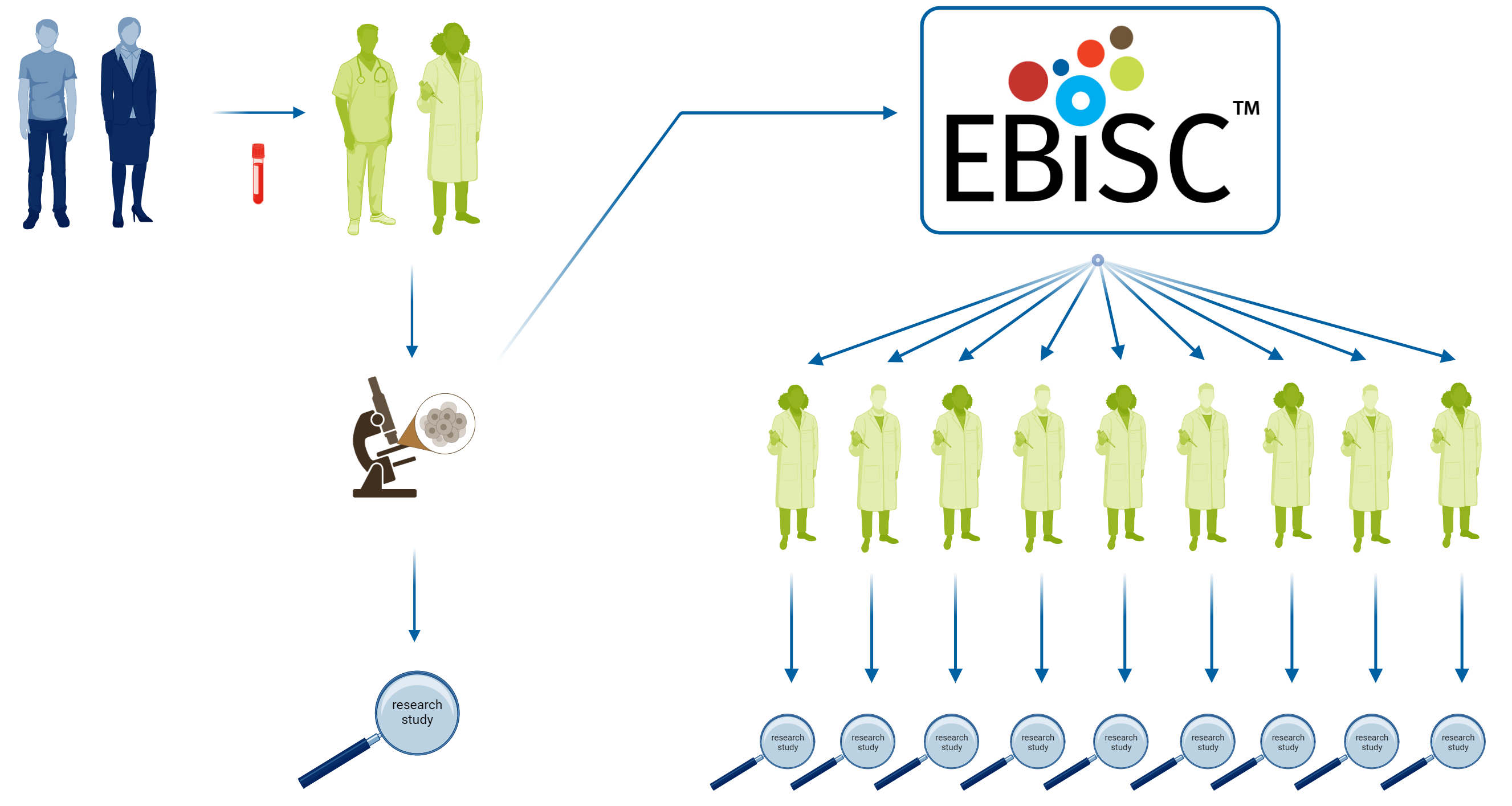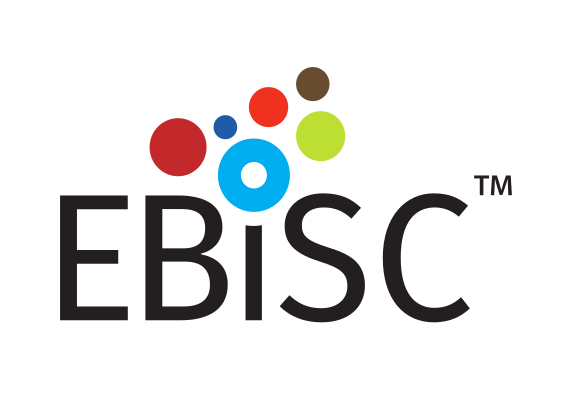Information for general public
Summary:
- EBiSC is a stem cell ‘biobank’
- EBiSC stores a certain type of stem cell and shares these stem cells to scientists worldwide for them to
use in their research
- These stem cells are called ‘induced pluripotent stem cells’, or iPSCs. The discovery of iPSC cells won
the 2012 Nobel Prize in Physiology or Medicine because they have such high impact on research.
- iPSCs are particularly useful for medical research because they have the ability to develop into other
cell types of the human body, like muscle, nerve or liver cells.
- The stem cells have been made by lots of different research groups across the world
- Research groups share their stem cell lines into EBiSC to help support research
What is EBiSC?
EBiSC is a not-for-profit ‘stem cell biobank’, which stores and shares a particular type of stem cell to
make
them easily available to researchers in Europe and around the world. EBiSC was initially founded through
collaborations supported by European funding and included universities, small research organisations and
large
pharmaceutical companies. It is now operated by facilities within EU and the United Kingdom.
EBiSC provides an important resource for researchers, who want to use stem cells to help understand disease,
to develop new drugs and to find new methods for creating therapies that might in future replace or treat
damaged and diseased tissue.
EBiSC supports lots of different research projects which are aiming to advance biomedical research. Sharing
stem cells and data has the potential to generate long term public health benefits and increase social
well-being. EBiSC charges a reasonable fee to researchers who obtain these stem cells from the Bank to
sustain
operations of the bank, allowing new stem cells to be collected and covering costs for re-stocking and
performing quality checks on the cells.
iPSC lines are valuable resources that are made available for research, thanks to the willingness of
research
participants. Here’s an example of how a participant could engage in iPSC research:
- Jane has been diagnosed with Alzheimer disease and her clinician asks if she would like to join a
research
study.
- She is informed about what it would require, including the risks, and then gives consent.
- Jane donates a small amount of blood and consents to share some basic details about herself such as her
genetic sex, her age (56) and her disease diagnosis.
- The blood sample is given to researchers, who make an induced pluripotent stem cell line from it.
- The researchers then share the stem cell line to EBiSC.
- EBiSC lists the stem cell line on the catalogue under an anonymised cell line ID e.g. ‘ABCDi003-A’ along
with the listed genetic sex, disease diagnosis and age range (55-59).
- Scientists across the world can then access this stem cell line to research Alzheimer disease
- For example, they could direct the stem cell line to make brain cells, to look at how brain cells from
an
Alzheimer disease patient function and monitor signs of disease.
What kind of stem cells does EBiSC work with?
EBiSC works with a type of stem cell called ‘induced pluripotent stem cells’, or iPSCs. These are a type of
‘pluripotent’ stem cell, which means that they can grow into most cell types in the human body, such as
muscle, nerve, or liver cells.
These cells are made from samples of tissue (donated by adults and sometimes children), such as blood, skin
or
hair follicles, and ‘induced’ in the laboratory to become pluripotent.
They are different from embryonic stem cells, which are naturally pluripotent and can only be made from an
early stage developing embryo. This kind of induced pluripotent stem cell can be cultured and expanded in a
laboratory and can theoretically survive forever.
The founders of the groundbreaking iPSC technology, Sir John B Gurdon and Shinya Yamanaka, were awarded the
2012 Nobel Prize in Medicine or Physiology.
These cells are very useful research tools as it means stem cells can be generated from individuals
diagnosed
with a disease and their disease can then be modelled in a laboratory to better understand how a disease is
caused, how it progresses and to find new treatments.
Importantly, they are made from tissue from individuals who have been fully informed and are willingly
consenting to tissue donation.

Individuals volunteer to donate tissue (e.g. a blood sample) to researchers, who then make iPS cells
from
it. Without EBiSC,
the iPS cells likely remain with the laboratory who originally made it. With EBiSC, we can share these
cells to many research
laboratories worldwide, making iPSC research easier and more accessible and helping to accelerate
research.
What does EBiSC do?
EBiSC collects stem cells which have been generated by different research organisations so that we can share
them with other researchers. This means we:
- Complete a legal agreement with the organisation who made the stem cells. Part of this legal agreement
is
to assure that the identity of individuals who have donated tissue is protected in line with the GDPR.
- Check the consent which the individual donating tissue signed to make sure that the individual was fully
informed as to how their tissue and data would be used. Importantly, EBiSC ensures that the samples were
collected in an ethical manner, consistent with international guidelines for human biomedical research.
- Store the stem cells in our laboratory
- Check the quality of all stem cells using a standard set of assays.
- List the stem cells and related information on the EBiSC catalogue, making sure that all information is
anonymised and cannot be linked back to the individual.
- EBiSC may use the stem cells to generate specific cell types, such as nerve cells, and provide these
cells
to researchers in order to make research easier for scientists to perform.
- Share the stem cells and derived cell types to non-profit and commercial researchers worldwide.
More information:
- EuroStemCell is a publicly available resource with lots of information on stem cells and how they can be
used in research:
https://www.eurostemcell.org/stem-cells-future-introduction-ips-cells
- The International Society of Stem Cell Research is an international body who works with researchers to
share research updates and set guidelines and standards for research activities:
https://www.aboutstemcells.org/
- If you want to volunteer to participate in research studies, there are lots of different ways to do
this, dependent on where you live and your health status. For example:

